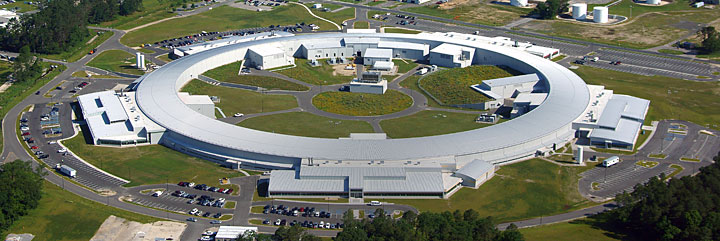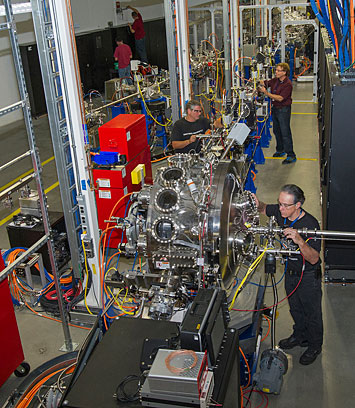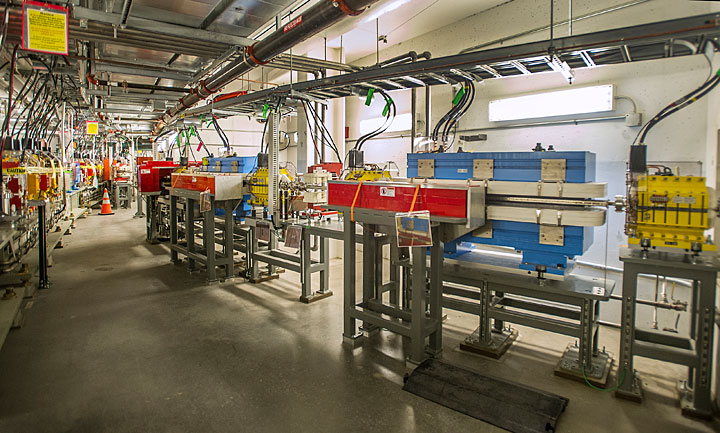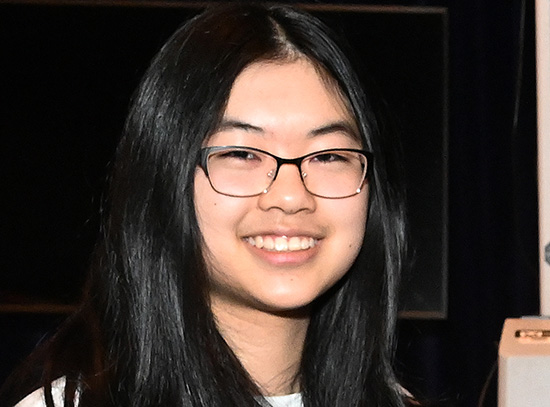Discover NSLS-II
September 14, 2017
 enlarge
enlarge
An aerial view of the National Synchrotron Light Source II at Brookhaven National Laboratory in Upton, NY.
Welcome to the National Synchrotron Light Source II (NSLS-II), one of the world's most advanced synchrotrons. Researchers from around the globe are coming to NSLS-II for its cutting-edge x-ray science and technology. At NSLS-II, scientists study the most important challenges in condensed matter and materials physics, chemistry, biology, and beyond.
Located at the U.S. Department of Energy’s (DOE) Brookhaven National Laboratory on Long Island, New York, NSLS-II is a DOE Office of Science User Facility that pushes the boundaries of synchrotron science, and its journey is only beginning. NSLS-II opened its doors to users just two years ago, and has welcomed more than 980 researchers this year alone. As NSLS-II continues to expand its facility and scientific capabilities, its doors are always open to new researchers from universities, national laboratories, and industry.
This animation demonstrates the multimodal nanoscale x-ray imaging that is available at beamline 3-ID.
NSLS-II is a state-of-the-art, medium-energy electron storage ring (three billion electron-volts) with a highly stable electron beam. The facility is designed to deliver highly intense and bright x-rays, and offers specialized operando experimental conditions, as well as multiscale and multimodal measurements that allow complex problems to be addressed using multiple research techniques.
Like all synchrotrons, NSLS-II generates light by circulating a beam of electrons. As the electrons move around the storage ring, they change direction and emit light of varying wavelengths, from the infrared range to x-rays. At multiple points around the ring, the light is directed down a beam path, called “beamlines,” to a scientific research instrument, where scientists can study materials with nanoscale resolution and exquisite sensitivity.
 enlarge
enlarge
Beamline 23-ID-1 at NSLS-II provides coherent soft x-ray scattering and imaging capabilities with world-leading high-coherent flux, as well as detectors for probing correlated electronic textures and dynamics.
NSLS-II currently has 20 beamlines open for general user operations. When built to full capacity, NSLS-II will have approximately 60 beamlines; in other words, at least 60 different experiments could run simultaneously. Each beamline at NSLS-II offers unique, cutting-edge research tools, including high-throughput robot-driven sample processing, coherent scattering with unprecedented spatial and energy resolution, and a hard x-ray microscope with world-leading, nanometer spatial resolution. The beamlines at NSLS-II are organized into six scientific programs, based on the research techniques they offer.
The Hard X-Ray Spectroscopy program strives to study real systems in complex environments over extended times. Its advanced spectroscopy tools cover multiple wavelengths with high spatial and energy resolution and a wide range of photon and electron detection methods. It includes the following beamlines:
- 6-BM: Materials Measurement (BMM) (under commissioning)
- 7-ID-1: Spectroscopy Soft and Tender (SST-1) (under construction)
- 7-ID-2: Spectroscopy Soft and Tender (SST-2) (under construction)
- 7-BM: Quick X-ray Absorption and Scattering (QAS) (under commissioning)
- 8-ID: Inner Shell Spectroscopy (ISS)
- 8-BM: Tender Energy X-ray Absorption Spectroscopy (TES) (under commissioning)
The Imaging & Microscopy program takes full advantage of NSLS-II’s high level of brightness and small source size to image and investigate heterogeneous structures and chemistries under in-situ conditions. The beamlines included in this program are:
- 3-ID: Hard X-ray Nanoprobe (HXN)
- 4-BM: X-ray Fluorescence Microprobe (XFM)
- 5-ID: Submicron Resolution X-ray Spectroscopy (SRX)
- 18-ID: Full-Field X-ray Imaging (FXI) (under construction)
The Structural Biology program offers an assortment of world-class tools that combine micro focus beams and high photon density. It enables discovery-class research on fundamental biological questions with the following beamlines:
- 16-ID: Life Science X-ray Scattering (LIX)
- 17-ID-1: Highly Automated Macromolecular Crystallography (AMX)
- 17-ID-2: Frontier Microfocusing Macromolecular Crystallography (FMX)
- 17-BM: X-ray Footprinting for In Vitro and In Vivo Structural Studies of Biological Macromolecules (XFP)
- 19-ID: Biological Microdiffraction Facility (NYX) (under commissioning)
The Soft X-Ray Scattering & Spectroscopy program explores the vast scientific questions centered around the electronic properties and behavior in quantum materials. Through a unique suite of beamline end stations, the program enables the measurement of electronic structure with unprecedented spectral, spatial and temporal resolution. The following beamlines directly benefit from the brightness of NSLS-II in the soft x-ray spectral region:
- 2-ID: Soft Inelastic X-ray Scattering (SIX) (under commissioning)
- 21-ID: Electron Spectro-Microscopy (ESM)
- 22-IR-1: Frontier Synchrotron Infrared Spectroscopy (FIS) (under construction)
- 22-IR-2: Magnetospectroscopy, Ellipsomentry and Time-Resolved Optical Spectroscopies (MET) (under construction)
- 23-ID-1: Coherent Soft X-ray Scattering (CSX-1)
- 23-ID-2: Soft X-ray Spectroscopy and Polarization (CSX-2)
The Complex Scattering program uses the ultra-bright x-rays at NSLS-II and coherence to study complex mesoscale materials and the complicated dynamics of heterogeneous and non-equilibrium systems. It includes the following beamlines:
- 10-ID: Inelastic X-ray Scattering (IXS)
- 11-ID: Coherent Hard X-ray Scattering (CHX)
- 11-BM: Complex Materials Scattering (CMS)
- 12-ID: Soft Matter Interfaces (SMI)
The Diffraction & In Situ Scattering program offers world-class tools to address a wide range of fundamental and applied material research problems under in-situ and operando conditions. The beamlines included in this program are:
- 4-ID: Integrated In-situ and Resonant Hard X-ray Studies (ISR)
- 28-ID-1: Total Scattering Beamline (PDF) (under construction)
- 28-ID-2: X-Ray Powder Diffraction (XPD)
- 27-ID: High Energy Engineering X-rays (HEX) (under construction)
All of the scientific programs at NSLS-II are collaborative, and the staff scientists share their expertise across the facility. Together, these programs drive innovation and discovery in four primary areas of science: self-assembly, clean and affordable energy, molecular electronics, and structural biology. While these scientific themes are the primary focus of NSLS-II, its research possibilities are endless.
As NSLS-II looks toward the future, the continued evolution of its accelerators is an essential part of the facility’s strategy. In the next five years, NSLS-II plans to pursue developments that support reliable storage-ring operations for user programs, developments that are required to ramp up the storage-ring performance to its design values, and R&D that will lead to enhanced NSLS-II source performance beyond design specifications.
Thank you for reading News @ NSLS-II, and for taking the time to learn more about this remarkable facility. We hope to see you at NSLS-II soon!
2017-12507 | INT/EXT | Newsroom










